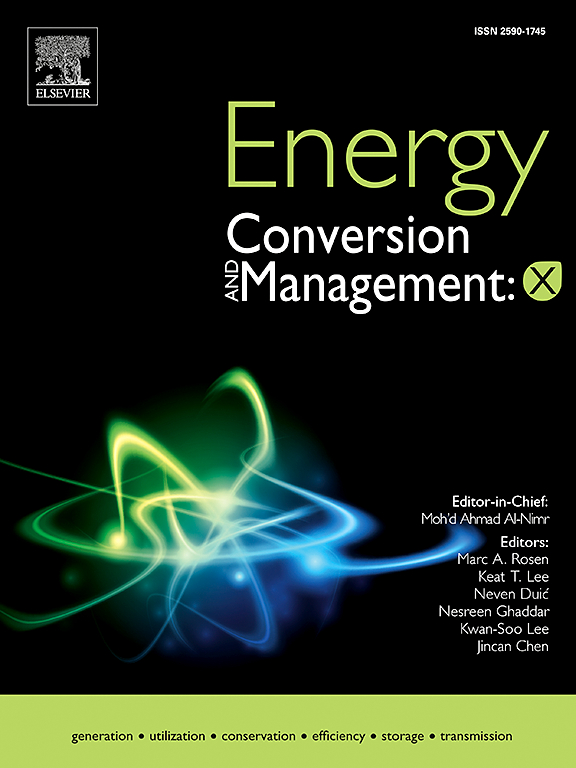A review on advanced phase change material-based cooling for energy-efficient electronics
IF 7.1
Q1 ENERGY & FUELS
引用次数: 0
Abstract
Increased power densities brought about by the quick development of high-power electronic devices call for effective thermal management to guarantee optimum performance and endurance. PCMs offer a passive and sustainable cooling solution, enhancing system reliability and energy efficiency. To maximize thermal energy management in electronic devices, this study intends to examine recent developments in PCM-based cooling systems over the previous five years, emphasizing their integration with hybrid cooling technologies such as fins, heat pipes, and nanoparticle-enhanced PCMs. In contrast to traditional reviews, this work focuses on hybrid PCM designs, demonstrating how heat dissipation is greatly enhanced by combining PCMs with nanomaterials, expanded surfaces, and active cooling approaches. Energy consumption in cooling systems can be reduced by optimizing these thermal management techniques, which will support sustainable energy management objectives. A thorough evaluation of recent research was carried out to assess the thermal performance of several PCM types, such as paraffin wax and RT-35HC, as well as nano-enhanced PCMs infused with graphene and metallic nanoparticles. Their effects on lowering temperatures and improving thermal conductivity in electronic cooling applications are the main topic of the review. While nano-enhanced PCMs exhibit a thermal conductivity gain of more than 100 %, paraffin wax-based PCMs can lower operating temperatures by up to 15 °C. High-power electronics showed temperature reductions of about 10 °C using RT-35HC, demonstrating the promise of hybrid PCM systems for energy-efficient cooling solutions.
基于先进相变材料的节能电子器件冷却研究进展
大功率电子器件的快速发展带来了功率密度的增加,需要有效的热管理来保证最佳的性能和耐用性。pcm提供了被动和可持续的冷却解决方案,提高了系统的可靠性和能源效率。为了最大限度地提高电子设备的热能管理,本研究旨在研究过去五年来基于pcm的冷却系统的最新发展,强调它们与混合冷却技术(如翅片、热管和纳米颗粒增强的pcm)的集成。与传统的评论相反,这项工作侧重于混合PCM设计,展示了如何通过将PCM与纳米材料、膨胀表面和主动冷却方法相结合来大大增强散热。通过优化这些热管理技术,可以降低冷却系统的能耗,这将支持可持续能源管理目标。对最近的研究进行了全面的评估,以评估几种PCM类型的热性能,如石蜡和RT-35HC,以及注入石墨烯和金属纳米颗粒的纳米增强PCM。它们在电子冷却应用中降低温度和改善导热性的作用是本文的主要主题。虽然纳米增强的pcm表现出超过100%的导热系数增益,但石蜡基pcm可以将工作温度降低高达15°C。使用RT-35HC的大功率电子设备显示温度降低了约10°C,证明了混合PCM系统用于节能冷却解决方案的前景。
本文章由计算机程序翻译,如有差异,请以英文原文为准。
求助全文
约1分钟内获得全文
求助全文
来源期刊

Energy Conversion and Management-X
Multiple-
CiteScore
8.80
自引率
3.20%
发文量
180
审稿时长
58 days
期刊介绍:
Energy Conversion and Management: X is the open access extension of the reputable journal Energy Conversion and Management, serving as a platform for interdisciplinary research on a wide array of critical energy subjects. The journal is dedicated to publishing original contributions and in-depth technical review articles that present groundbreaking research on topics spanning energy generation, utilization, conversion, storage, transmission, conservation, management, and sustainability.
The scope of Energy Conversion and Management: X encompasses various forms of energy, including mechanical, thermal, nuclear, chemical, electromagnetic, magnetic, and electric energy. It addresses all known energy resources, highlighting both conventional sources like fossil fuels and nuclear power, as well as renewable resources such as solar, biomass, hydro, wind, geothermal, and ocean energy.
 求助内容:
求助内容: 应助结果提醒方式:
应助结果提醒方式:


